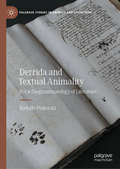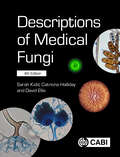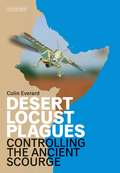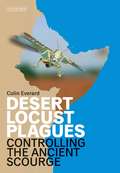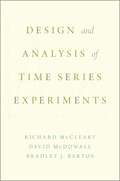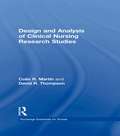- Table View
- List View
Dermoscopy in General Dermatology
by Aimilios Lallas Enzo Errichetti Dimitrios IoannidesThis lavishly illustrated guide from experts will enable practitioners to get the most out of dermoscopy for investigations and treatments in general dermatology.
Dermoscopy in General Dermatology
by Aimilios Lallas Enzo Errichetti Dimitrios IoannidesThis lavishly illustrated guide from experts will enable practitioners to get the most out of dermoscopy for investigations and treatments in general dermatology.
Dermoscopy in General Dermatology
by Aimilios Lallas Enzo Errichetti Dimitrios IoannidesThis lavishly illustrated guide from experts will enable practitioners to get the most out of dermoscopy for investigations and treatments in general dermatology.
Dermoscopy in General Dermatology for Skin of Color
by Enzo Errichetti Aimilios LallasDermoscopy can be a useful tool to evaluate skin of color for general dermatologic diseases; however, it does require practitioners to be aware of many points of difference from patients with lighter phototypes. This highly illustrated text brings together the pioneering experience of international experts to document patients of phototypes IV to VI (from subcontinental Asian, North African, South American, to African skin).
Dermoscopy in General Dermatology for Skin of Color
by Msc Enzo Md, Msc Enzo Errichetti MSc Aimilios Md, MSc Aimilios LallasDermoscopy can be a useful tool to evaluate skin of color for general dermatologic diseases; however, it does require practitioners to be aware of many points of difference from patients with lighter phototypes. This highly illustrated text brings together the pioneering experience of international experts to document patients of phototypes IV to VI (from subcontinental Asian, North African, South American, to African skin).
Dermoscopy of the Hair and Nails
by Antonella TostiWhen the first edition of this pioneering text was published, only a few dermatologists were trained to utilize the dermatoscope for the diagnosis and follow-up of hair diseases. The technique is now more popular worldwide, prompting the development of this updated second edition, which now includes a section devoted entirely to nail dermoscopy and
Derrida and Textual Animality: For a Zoogrammatology of Literature (Palgrave Studies in Animals and Literature)
by Rodolfo PiskorskiDerrida and Textual Animality: For a Zoogrammatology of Literature analyses what has come to be known, in the Humanities, as ‘the question of the animal’, in relation to literary texts. Rodolfo Piskorski intervenes in the current debate regarding the non-human and its representation in literature, resisting popular materialist methodological approaches in the field by revisiting and revitalising the post-structuralist thought of Derrida and the ‘linguistic turn’. The book focuses on Derrida’s early work in order to frame deconstructive approaches to literature as necessary for a theory and practice of literary criticism that addresses the question of the animal, arguing that texts are like animals, and animals are like texts. While Derrida’s late writings have been embraced by animal studies scholars due to its overt focus on animality, ethics, and the non-human, Piskorski demonstrates the additional value of these early Derridean texts for the field of literary animal studies by proposing detailed zoogrammatological readings of texts by Freud, Clarice Lispector, Ted Hughes, and Darren Aronofsky, while in dialogue with thinkers such as Butler, Kristeva, Genette, Deleuze and Guattari, and Attridge.
Descended and Cryptorchid Testis (Clinics in Andrology #3)
by E. S. E.HafezDuring the past decade extensive investigations have been done on the testis. Since the observations have been published in many different journals. it seemed appropriate to bring together and summarize some of the pertinent findings in a single volume. Twenty-eight scientists and clinicians from nine countries have contributed to this book. They have reviewed the literature and presented their own, new observations on the developmentaL anatomicaL physiologicaL biochemical and pathological aspects of the descended and cryptorchid testis. In addition, several contributors have evaluated the usefulness of certain animals as models for systematically studying specific aspects of cryptorchidism. It is hoped that this volume will serve as a useful summary and reference for those working in this area and that it will encourage further research in testicular physiopathology. The editor thanks the contributors for their enthusiasm, cooperation and meticulous writing of the chapters. The support of the Departments of GynecologyjObstetrics and the Department of Physiology of Wayne State University School of Medicine. Detroit and the assistance from the staff of Martinus Nijhoff are gratefully acknowledged. The cheerful cooperation of Miss Lori Rust and Miss Penny Stoops who helped to type and assemble the volume is most deeply appreciated.
Descending with angels: Islamic exorcism and psychiatry: a film monograph (Anthropology, Creative Practice and Ethnography)
by Christian SuhrOver several years, Christian Suhr followed Muslim patients being treated for jinn possession and psychosis in a Danish mosque and in a psychiatric hospital. Through rich filmic and textual case studies, he shows how the bodies and souls of Muslim patients become a battlefield between the moral demands of Islam and the psychiatric institutions of European nation-states. The book reveals how both psychiatric and Islamic healing work to produce relief from pain, and also entail an ethical transformation of the patient and the cultivation of religious and secular values through the experience of pain. Creatively exploring the analytic possibilities provided by the use of a camera, both text and film show how disruptive ritual techniques are used in healing to destabilise individual perceptions and experiences of agency, which allows patients to submit to the invisible powers of psychotropic medicine or God.
Descending with angels: Islamic exorcism and psychiatry: a film monograph (Anthropology, Creative Practice and Ethnography)
by Christian SuhrOver several years, Christian Suhr followed Muslim patients being treated for jinn possession and psychosis in a Danish mosque and in a psychiatric hospital. Through rich filmic and textual case studies, he shows how the bodies and souls of Muslim patients become a battlefield between the moral demands of Islam and the psychiatric institutions of European nation-states. The book reveals how both psychiatric and Islamic healing work to produce relief from pain, and also entail an ethical transformation of the patient and the cultivation of religious and secular values through the experience of pain. Creatively exploring the analytic possibilities provided by the use of a camera, both text and film show how disruptive ritual techniques are used in healing to destabilise individual perceptions and experiences of agency, which allows patients to submit to the invisible powers of psychotropic medicine or God.
Descent of the Testis
by John M. Hutson Jørgen Mogens Thorup Spencer W. BeasleyThis book provides a state of the art overview of all aspects of testicular descent and cryptorchidism, including the mechanisms of descent and the causes, consequences, diagnosis, and treatment of undescended testis. The advances in understanding that have been achieved over the past two decades are clearly explained, covering the latest genetic information on the causes of normal and abnormal testicular descent, the role of INSL3 in transabdominal migration, and the evidence that a neurotransmitter released from the genitofemoral nerve mediates androgenic control of inguinoscrotal descent. Exciting changes in the management of both congenital and acquired cryptorchidism, such as the widespread use of laparoscopy for impalpable testes inside the abdominal cavity, are fully described. Evidence for the benefits of orchidopexy within the first year of life is reviewed, and an individual chapter is also devoted to hormonal treatment. Throughout the book due attention is given to ongoing controversies and divergences of opinion. This new edition of Descent of the Testis will be a timely update and valuable reference for all who are involved in research into testicular descent and management of cryptorchidism.
Descriptions of Medical Fungi
by Dr Sarah Kidd Dr Catriona Halliday Professor David EllisThe 4th edition of this book provides laboratory staff and clinicians with a quick benchtop reference on the identification and antifungal susceptibility of human and animal fungal infections. It contains descriptions of all the major medical fungal pathogens, 179 species from 109 genera. This updated edition includes new and revised descriptions and he authors have reconciled current morphological descriptions and name changes with more recent genetic data. The most common fungal species are described, including members of the yeasts, mucoromycetes, conidial moulds, dimorphic pathogens, and dermatophytes. The book features: updates to taxonomy and fungal names. more than 350 colour photographs. antifungal susceptibility profiles, including for new drugs where available. methods of identification including molecular and/or MALDI-ToF mass spectroscopy. This handy reference is essential for laboratory staff and clinicians dealing with the identification and management of human and animal fungal infections, researchers in medical microbiology and mycology laboratories.
Desert King, Doctor Daddy (Mills And Boon Medical Ser.)
by Meredith WebberSheikh surgeon, royal bride As a powerful ruler, Sheikh Yusef Akkedi is certain his kingdom will benefit from Dr Gemma Murray’s renowned approach to medicine. As a single father, he’s amazed by the immediate connection between Gemma and his tiny daughter. And as a red-blooded man, he can’t resist her deliciously tempting beauty.
Desert Locust Plagues: Controlling the Ancient Scourge
by Robert A. Cheke Colin EverardFor thousands of years, humans have found themselves vulnerable to plagues of desert locusts. Some fifty countries in Africa, the Middle East and Asia have been ravaged, at one time or another, by huge, devouring swarms of locusts. With the consequent, often total, destruction of crops and grazing, widespread hunger and starvation ensued. Colin Everard's book takes as its geographical focus the Horn of Africa, an area which throughout history has suffered catastrophically from locust plagues. Based on his own extensive experience in the region, Everard describes one of the greatest (albeit unsung) triumphs of the twentieth century, namely, how the desert locust scourge has, at last, been virtually brought under control.
Desert Locust Plagues: Controlling the Ancient Scourge
by Colin Everard Robert A. ChekeFor thousands of years, humans have found themselves vulnerable to plagues of desert locusts. Some fifty countries in Africa, the Middle East and Asia have been ravaged, at one time or another, by huge, devouring swarms of locusts. With the consequent, often total, destruction of crops and grazing, widespread hunger and starvation ensued. Colin Everard's book takes as its geographical focus the Horn of Africa, an area which throughout history has suffered catastrophically from locust plagues. Based on his own extensive experience in the region, Everard describes one of the greatest (albeit unsung) triumphs of the twentieth century, namely, how the desert locust scourge has, at last, been virtually brought under control.
Desert Malaria: An Emerging Malaria Paradigm and Its Global Impact on Disease Elimination
by B.K. TyagiThis book comprehensively reviews the disease dynamics, distribution, surveillance, epidemiology, diagnosis, control strategies, and management of the desert malaria. It highlights the potential risks of unstable but often exacerbated malaria conflagration as epidemics in the middle of duned desert, a desert oasis, and desert-fringe regions. Further, it reveals the factors inveigled into desert environments due to extensive anthropogenic activities such as canalized irrigation projects, high-yielding new agriculture practices, human concentration, and increased trade. It addresses the impact of irrigation on the malarial dynamics and its coupling to the climate forcing. The book also offers a model for desert transformation into malaria heaven under the changed climatic conditions including high rainfall, humidity, and depletion in temperature. Lastly, it offers insight into malaria epidemiology and disease control in the desert’s arid environments. This book is an essential resource for medical entomologists, parasitologists, epidemiologists, and public health researchers.
The Desert Surgeon's Secret Son (Mills And Boon Medical Ser.)
by Olivia GatesEnter into the world of high-flying Doctors as they navigate the pressures of modern medicine and find escape, passion, comfort and love – in each other’s arms! The Sheikh’s new-found son
Design, Analysis, and Interpretation of Genome-Wide Association Scans (Statistics for Biology and Health)
by Daniel O. StramThis book presents the statistical aspects of designing, analyzing and interpreting the results of genome-wide association scans (GWAS studies) for genetic causes of disease using unrelated subjects. Particular detail is given to the practical aspects of employing the bioinformatics and data handling methods necessary to prepare data for statistical analysis. The goal in writing this book is to give statisticians, epidemiologists, and students in these fields the tools to design a powerful genome-wide study based on current technology. The other part of this is showing readers how to conduct analysis of the created study.Design and Analysis of Genome-Wide Association Studies provides a compendium of well-established statistical methods based upon single SNP associations. It also provides an introduction to more advanced statistical methods and issues. Knowing that technology, for instance large scale SNP arrays, is quickly changing, this text has significant lessons for future use with sequencing data. Emphasis on statistical concepts that apply to the problem of finding disease associations irrespective of the technology ensures its future applications. The author includes current bioinformatics tools while outlining the tools that will be required for use with extensive databases from future large scale sequencing projects. The author includes current bioinformatics tools while outlining additional issues and needs arising from the extensive databases from future large scale sequencing projects.
DESIGN & ANALYSIS TIME SERIES EXPERIM C
by David McDowall Richard McCleary Bradley BartosDesign and Analysis of Time Series Experiments presents the elements of statistical time series analysis while also addressing recent developments in research design and causal modeling. A distinguishing feature of the book is its integration of design and analysis of time series experiments. Readers learn not only how-to skills but also the underlying rationales for design features and analytical methods. ARIMA algebra, Box-Jenkins-Tiao models and model-building strategies, forecasting, and Box-Tiao impact models are developed in separate chapters. The presentation of the models and model-building assumes only exposure to an introductory statistics course, with more difficult mathematical material relegated to appendices. Separate chapters cover threats to statistical conclusion validity, internal validity, construct validity, and external validity with an emphasis on how these threats arise in time series experiments. Design structures for controlling the threats are presented and illustrated through examples. The chapters on statistical conclusion validity and internal validity introduce Bayesian methods, counterfactual causality, and synthetic control group designs. Building on the earlier time series books by McCleary and McDowall, Design and Analysis of Time Series Experiments includes recent developments in modeling, and considers design issues in greater detail than does any existing work. Drawing examples from criminology, economics, education, pharmacology, public policy, program evaluation, public health, and psychology, the text is addressed to researchers and graduate students in a wide range of behavioral, biomedical and social sciences. It will appeal to those who want to conduct or interpret time series experiments, as well as to those interested in research designs for causal inference.
Design and Analysis of Bioavailability and Bioequivalence Studies
by Shein-Chung Chow Jen-pei LiuPreeminent Experts Update a Well-Respected BookTaking into account the regulatory and scientific developments that have occurred since the second edition, Design and Analysis of Bioavailability and Bioequivalence Studies, Third Edition provides a complete presentation of the latest progress of activities and results in bioavailability and bioequiva
Design and Analysis of Clinical Nursing Research Studies
by Colin R Martin David R ThompsonThis invaluable text on the design and analysis of clinical research studies explains the basis of experimental design and statistics in a way that is sensitive to the clinical context in which nurses work. It uses data from actual studies to illustrate how to:*design the study*use and select data*present research findings*use a computer for statistical analysis.The scope of the study designs and associated statistical techniques covered in the book allow both the beginning nurse researcher and the more seasoned professional nurse investigator to approach a research study with confidence and optimism. The authors show how qualitative data can be approached quantitatively, what the advantages of this are from the nursing viewpoint, and how quantitative methodology can help nurses to develop a common research language with other disciplines involved in patient care.
Design and Analysis of Clinical Nursing Research Studies
by Colin R Martin David R ThompsonThis invaluable text on the design and analysis of clinical research studies explains the basis of experimental design and statistics in a way that is sensitive to the clinical context in which nurses work. It uses data from actual studies to illustrate how to:*design the study*use and select data*present research findings*use a computer for statistical analysis.The scope of the study designs and associated statistical techniques covered in the book allow both the beginning nurse researcher and the more seasoned professional nurse investigator to approach a research study with confidence and optimism. The authors show how qualitative data can be approached quantitatively, what the advantages of this are from the nursing viewpoint, and how quantitative methodology can help nurses to develop a common research language with other disciplines involved in patient care.
Design and Analysis of Clinical Trials: Concepts and Methodologies (Wiley Series in Probability and Statistics #981)
by Shein-Chung Chow Jen-Pei LiuPraise for the Second Edition: “...a grand feast for biostatisticians. It stands ready to satisfy the appetite of any pharmaceutical scientist with a respectable statistical appetite.” —Journal of Clinical Research Best Practices The Third Edition of Design and Analysis of Clinical Trials provides complete, comprehensive, and expanded coverage of recent health treatments and interventions. Featuring a unified presentation, the book provides a well-balanced summary of current regulatory requirements and recently developed statistical methods as well as an overview of the various designs and analyses that are utilized at different stages of clinical research and development. Additional features of this Third Edition include: • New chapters on biomarker development and target clinical trials, adaptive design, trials for evaluating diagnostic devices, statistical methods for translational medicine, and traditional Chinese medicine • A balanced overview of current and emerging clinical issues as well as newly developed statistical methodologies • Practical examples of clinical trials that demonstrate everyday applicability, with illustrations and examples to explain key concepts • New sections on bridging studies and global trials, QT studies, multinational trials, comparative effectiveness trials, and the analysis of QT/QTc prolongation • A complete and balanced presentation of clinical and scientific issues, statistical concepts, and methodologies for bridging clinical and statistical disciplines • An update of each chapter that reflects changes in regulatory requirements for the drug review and approval process and recent developments in statistical design and methodology for clinical research and development Design and Analysis of Clinical Trials, Third Edition continues to be an ideal clinical research reference for academic, pharmaceutical, medical, and regulatory scientists/researchers, statisticians, and graduate-level students.
Design and Analysis of Clinical Trials: Concepts and Methodologies (Wiley Series in Probability and Statistics #979)
by Shein-Chung Chow Jen-Pei LiuPraise for the Second Edition: “...a grand feast for biostatisticians. It stands ready to satisfy the appetite of any pharmaceutical scientist with a respectable statistical appetite.” —Journal of Clinical Research Best Practices The Third Edition of Design and Analysis of Clinical Trials provides complete, comprehensive, and expanded coverage of recent health treatments and interventions. Featuring a unified presentation, the book provides a well-balanced summary of current regulatory requirements and recently developed statistical methods as well as an overview of the various designs and analyses that are utilized at different stages of clinical research and development. Additional features of this Third Edition include: • New chapters on biomarker development and target clinical trials, adaptive design, trials for evaluating diagnostic devices, statistical methods for translational medicine, and traditional Chinese medicine • A balanced overview of current and emerging clinical issues as well as newly developed statistical methodologies • Practical examples of clinical trials that demonstrate everyday applicability, with illustrations and examples to explain key concepts • New sections on bridging studies and global trials, QT studies, multinational trials, comparative effectiveness trials, and the analysis of QT/QTc prolongation • A complete and balanced presentation of clinical and scientific issues, statistical concepts, and methodologies for bridging clinical and statistical disciplines • An update of each chapter that reflects changes in regulatory requirements for the drug review and approval process and recent developments in statistical design and methodology for clinical research and development Design and Analysis of Clinical Trials, Third Edition continues to be an ideal clinical research reference for academic, pharmaceutical, medical, and regulatory scientists/researchers, statisticians, and graduate-level students.
Design and Analysis of Clinical Trials for Predictive Medicine (Chapman And Hall/crc Biostatistics Ser.)
by Shigeyuki Matsui Marc Buyse Richard SimonDesign and Analysis of Clinical Trials for Predictive Medicine provides statistical guidance on conducting clinical trials for predictive medicine. It covers statistical topics relevant to the main clinical research phases for developing molecular diagnostics and therapeutics-from identifying molecular biomarkers using DNA microarrays to confirming



